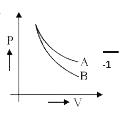Find the amount of work done to increase the temperature of one mole jof an ideal gas by 30∘C, if it is expanding under condition V∞T2/3.
The correct Answer is:166.2
To find the amount of work done to increase the temperature of one mole of an ideal gas by 30∘C under the condition V∝T2/3, we can follow these steps:
1. Understand the Ideal Gas Law:
The ideal gas law is given by the equation:
PV=nRT
Since we have 1 mole of gas, we can simplify this to:
PV=RT
2. Express Volume in Terms of Temperature:
Given the condition V∝T2/3, we can express volume as:
V=kT2/3
where k is a constant.
3. Substitute Volume into the Ideal Gas Law:
Substitute V into the ideal gas law:
P(kT2/3)=RT
Rearranging gives:
P=RTkT2/3=RkT1/3
Let C=Rk, then:
P=CT1/3
4. Calculate Work Done:
The work done W during an expansion is given by:
W=∫PdV
We need to express dV in terms of dT. From V=kT2/3:
dV=k⋅23T−1/3dT
5. Substitute P and dV into the Work Equation:
Substitute P and dV into the work formula:
W=∫PdV=∫CT1/3(k⋅23T−1/3dT)
This simplifies to:
W=∫2Ck3dT
6. Integrate:
The integral becomes:
W=2Ck3(T2−T1)
where T2 is the final temperature and T1 is the initial temperature.
7. Calculate Temperature Change:
The temperature change is given as 30∘C, which is equivalent to 30K (since the change in temperature is the same in both Celsius and Kelvin scales). Thus:
W=2Ck3⋅30
8. Substitute Constants:
Recall that C=Rk, so:
W=2R3⋅30
Now substituting R=8.314J/mol K:
W=2⋅8.3143⋅30
9. Calculate Final Work Done:
W=16.6283⋅30=166.28J
Final Answer:
The amount of work done to increase the temperature of one mole of an ideal gas by 30∘C is approximately 166.28J.
The ideal gas law is given by the equation:
PV=nRT
Since we have 1 mole of gas, we can simplify this to:
PV=RT
Given the condition V∝T2/3, we can express volume as:
V=kT2/3
where k is a constant.
Substitute V into the ideal gas law:
P(kT2/3)=RT
Rearranging gives:
P=RTkT2/3=RkT1/3
Let C=Rk, then:
P=CT1/3
The work done W during an expansion is given by:
W=∫PdV
We need to express dV in terms of dT. From V=kT2/3:
dV=k⋅23T−1/3dT
Substitute P and dV into the work formula:
W=∫PdV=∫CT1/3(k⋅23T−1/3dT)
This simplifies to:
W=∫2Ck3dT
The integral becomes:
W=2Ck3(T2−T1)
where T2 is the final temperature and T1 is the initial temperature.
The temperature change is given as 30∘C, which is equivalent to 30K (since the change in temperature is the same in both Celsius and Kelvin scales). Thus:
W=2Ck3⋅30
Recall that C=Rk, so:
W=2R3⋅30
Now substituting R=8.314J/mol K:
W=2⋅8.3143⋅30
W=16.6283⋅30=166.28J
The amount of work done to increase the temperature of one mole of an ideal gas by 30∘C is approximately 166.28J.
Topper's Solved these Questions
- BOOK - VMC MODULES ENGLISHCHAPTER - GASEOUS STATE & THERMODYNAMICSEXERCISE - JEE MAIN (ARCHIVE )81videos
GASEOUS STATE & THERMODYNAMICS
- BOOK - VMC MODULES ENGLISHCHAPTER - GASEOUS STATE & THERMODYNAMICSEXERCISE - JEE ADVANCED (ARCHIVE )111videos
GASEOUS STATE & THERMODYNAMICS
- BOOK - VMC MODULES ENGLISHCHAPTER - GASEOUS STATE & THERMODYNAMICSEXERCISE - Level - 175videos
GASEOUS STATE & THERMODYNAMICS
- BOOK - VMC MODULES ENGLISHCHAPTER - ENERGY & MOMENTUMEXERCISE - JEE ADVANCE (ARCHIVE) - TRUE/FALSE TYPE1videos
ENERGY & MOMENTUM
- BOOK - VMC MODULES ENGLISHCHAPTER - GRAVITATIONEXERCISE - JEE Advance (Archive) TRUE/FALSE1videos
GRAVITATION
Similar Questions
Find the amount of work done to increase the temperature of one mole of ideal gas by 30∘C .if its is expanding under the condition V∝R2/3(R=8.31J/mol−K):
View SolutionTemperature of 1 mole of a gas is increased by 2∘C at constant pressure. Work done is :
View SolutionWork done during isothermal expansion of one mole of an ideal gas from 10 atm to 1atm at 300 k is
View SolutionThe amount of heat required to raise the temperature of 2 mole of monoatomic gas under isobaric condition from 0∘C to 50∘C will be :-
View SolutionFor one mole of an ideal gas, increasing the temperature from 10∘C to 20∘C
View SolutionWork done during isothermal expansion of one mole of an ideal gas form 10atm to 1atm at 300K is (Gas constant=2)
View SolutionTemperature of one mole of a gas is increased by 1∘ C at constant pressure. The work done on the system is
 View Solution
View SolutionTemeprature of 1 mole of a gas is increased by 2∘ at constant pressure, then work done is :
View SolutionTwo moles of an ideal gas expand spontaneouly into vacuum. The work done is :-
View SolutionCalculate the work done during the process when one mole of gas is allowed to expand freely into vacuum.
View Solution

